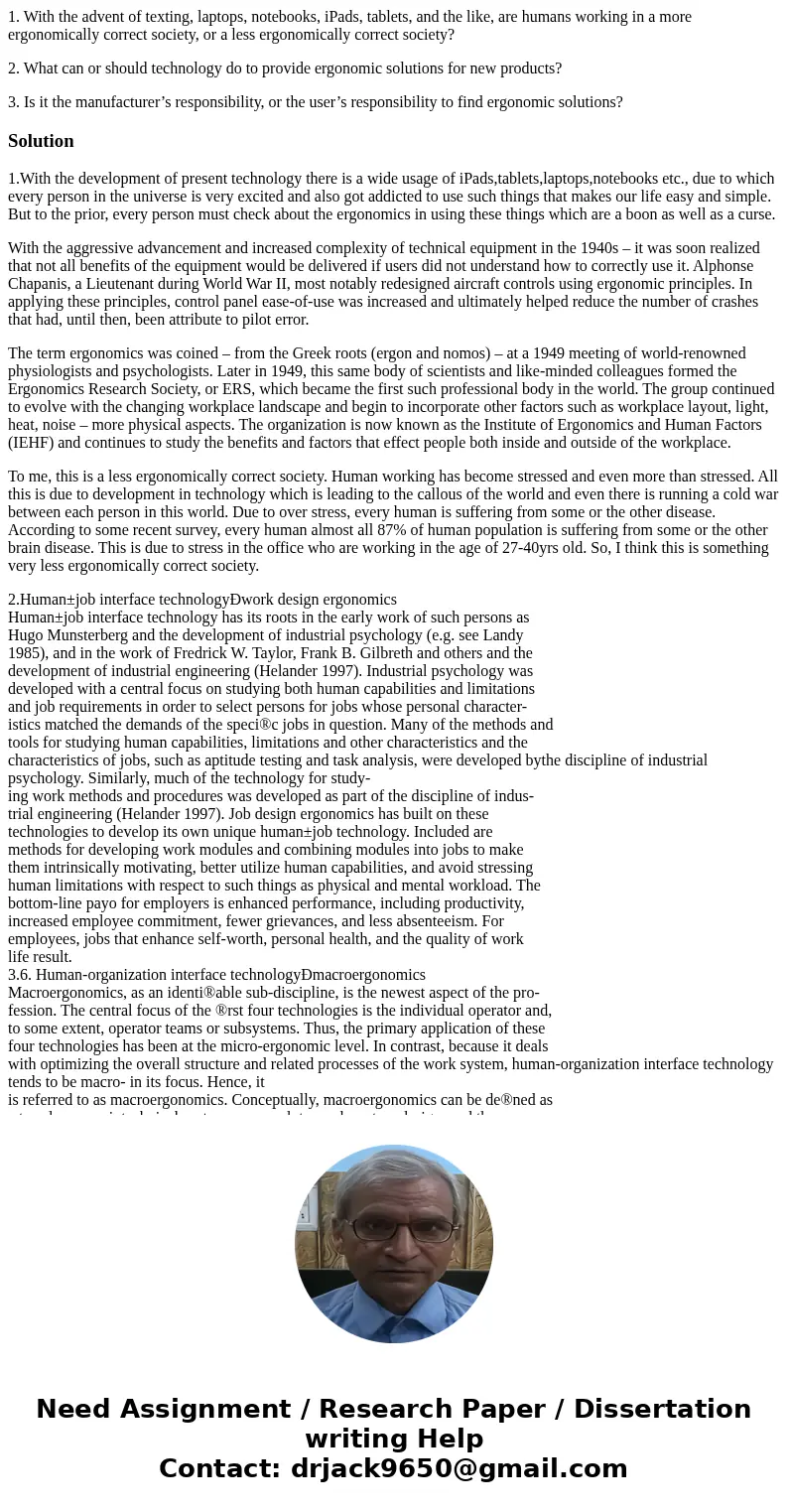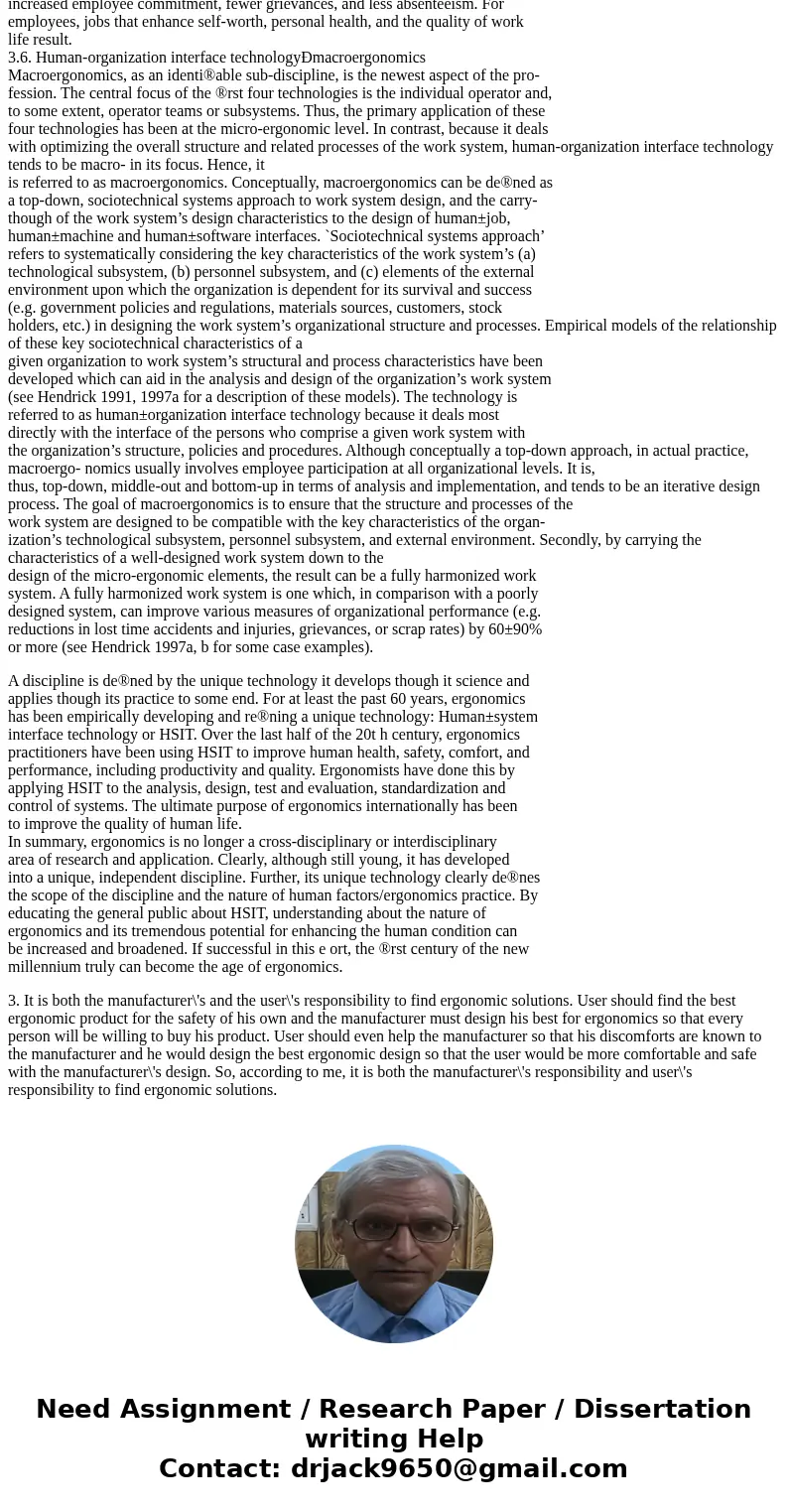1 With the advent of texting laptops notebooks iPads tablets
1. With the advent of texting, laptops, notebooks, iPads, tablets, and the like, are humans working in a more ergonomically correct society, or a less ergonomically correct society?
2. What can or should technology do to provide ergonomic solutions for new products?
3. Is it the manufacturer’s responsibility, or the user’s responsibility to find ergonomic solutions?
Solution
1.With the development of present technology there is a wide usage of iPads,tablets,laptops,notebooks etc., due to which every person in the universe is very excited and also got addicted to use such things that makes our life easy and simple. But to the prior, every person must check about the ergonomics in using these things which are a boon as well as a curse.
With the aggressive advancement and increased complexity of technical equipment in the 1940s – it was soon realized that not all benefits of the equipment would be delivered if users did not understand how to correctly use it. Alphonse Chapanis, a Lieutenant during World War II, most notably redesigned aircraft controls using ergonomic principles. In applying these principles, control panel ease-of-use was increased and ultimately helped reduce the number of crashes that had, until then, been attribute to pilot error.
The term ergonomics was coined – from the Greek roots (ergon and nomos) – at a 1949 meeting of world-renowned physiologists and psychologists. Later in 1949, this same body of scientists and like-minded colleagues formed the Ergonomics Research Society, or ERS, which became the first such professional body in the world. The group continued to evolve with the changing workplace landscape and begin to incorporate other factors such as workplace layout, light, heat, noise – more physical aspects. The organization is now known as the Institute of Ergonomics and Human Factors (IEHF) and continues to study the benefits and factors that effect people both inside and outside of the workplace.
To me, this is a less ergonomically correct society. Human working has become stressed and even more than stressed. All this is due to development in technology which is leading to the callous of the world and even there is running a cold war between each person in this world. Due to over stress, every human is suffering from some or the other disease. According to some recent survey, every human almost all 87% of human population is suffering from some or the other brain disease. This is due to stress in the office who are working in the age of 27-40yrs old. So, I think this is something very less ergonomically correct society.
2.Human±job interface technologyÐwork design ergonomics
Human±job interface technology has its roots in the early work of such persons as
Hugo Munsterberg and the development of industrial psychology (e.g. see Landy
1985), and in the work of Fredrick W. Taylor, Frank B. Gilbreth and others and the
development of industrial engineering (Helander 1997). Industrial psychology was
developed with a central focus on studying both human capabilities and limitations
and job requirements in order to select persons for jobs whose personal character-
istics matched the demands of the speci®c jobs in question. Many of the methods and
tools for studying human capabilities, limitations and other characteristics and the
characteristics of jobs, such as aptitude testing and task analysis, were developed bythe discipline of industrial psychology. Similarly, much of the technology for study-
ing work methods and procedures was developed as part of the discipline of indus-
trial engineering (Helander 1997). Job design ergonomics has built on these
technologies to develop its own unique human±job technology. Included are
methods for developing work modules and combining modules into jobs to make
them intrinsically motivating, better utilize human capabilities, and avoid stressing
human limitations with respect to such things as physical and mental workload. The
bottom-line payo for employers is enhanced performance, including productivity,
increased employee commitment, fewer grievances, and less absenteeism. For
employees, jobs that enhance self-worth, personal health, and the quality of work
life result.
3.6. Human-organization interface technologyÐmacroergonomics
Macroergonomics, as an identi®able sub-discipline, is the newest aspect of the pro-
fession. The central focus of the ®rst four technologies is the individual operator and,
to some extent, operator teams or subsystems. Thus, the primary application of these
four technologies has been at the micro-ergonomic level. In contrast, because it deals
with optimizing the overall structure and related processes of the work system, human-organization interface technology tends to be macro- in its focus. Hence, it
is referred to as macroergonomics. Conceptually, macroergonomics can be de®ned as
a top-down, sociotechnical systems approach to work system design, and the carry-
though of the work system’s design characteristics to the design of human±job,
human±machine and human±software interfaces. `Sociotechnical systems approach’
refers to systematically considering the key characteristics of the work system’s (a)
technological subsystem, (b) personnel subsystem, and (c) elements of the external
environment upon which the organization is dependent for its survival and success
(e.g. government policies and regulations, materials sources, customers, stock
holders, etc.) in designing the work system’s organizational structure and processes. Empirical models of the relationship of these key sociotechnical characteristics of a
given organization to work system’s structural and process characteristics have been
developed which can aid in the analysis and design of the organization’s work system
(see Hendrick 1991, 1997a for a description of these models). The technology is
referred to as human±organization interface technology because it deals most
directly with the interface of the persons who comprise a given work system with
the organization’s structure, policies and procedures. Although conceptually a top-down approach, in actual practice, macroergo- nomics usually involves employee participation at all organizational levels. It is,
thus, top-down, middle-out and bottom-up in terms of analysis and implementation, and tends to be an iterative design process. The goal of macroergonomics is to ensure that the structure and processes of the
work system are designed to be compatible with the key characteristics of the organ-
ization’s technological subsystem, personnel subsystem, and external environment. Secondly, by carrying the characteristics of a well-designed work system down to the
design of the micro-ergonomic elements, the result can be a fully harmonized work
system. A fully harmonized work system is one which, in comparison with a poorly
designed system, can improve various measures of organizational performance (e.g.
reductions in lost time accidents and injuries, grievances, or scrap rates) by 60±90%
or more (see Hendrick 1997a, b for some case examples).
A discipline is de®ned by the unique technology it develops though it science and
applies though its practice to some end. For at least the past 60 years, ergonomics
has been empirically developing and re®ning a unique technology: Human±system
interface technology or HSIT. Over the last half of the 20t h century, ergonomics
practitioners have been using HSIT to improve human health, safety, comfort, and
performance, including productivity and quality. Ergonomists have done this by
applying HSIT to the analysis, design, test and evaluation, standardization and
control of systems. The ultimate purpose of ergonomics internationally has been
to improve the quality of human life.
In summary, ergonomics is no longer a cross-disciplinary or interdisciplinary
area of research and application. Clearly, although still young, it has developed
into a unique, independent discipline. Further, its unique technology clearly de®nes
the scope of the discipline and the nature of human factors/ergonomics practice. By
educating the general public about HSIT, understanding about the nature of
ergonomics and its tremendous potential for enhancing the human condition can
be increased and broadened. If successful in this e ort, the ®rst century of the new
millennium truly can become the age of ergonomics.
3. It is both the manufacturer\'s and the user\'s responsibility to find ergonomic solutions. User should find the best ergonomic product for the safety of his own and the manufacturer must design his best for ergonomics so that every person will be willing to buy his product. User should even help the manufacturer so that his discomforts are known to the manufacturer and he would design the best ergonomic design so that the user would be more comfortable and safe with the manufacturer\'s design. So, according to me, it is both the manufacturer\'s responsibility and user\'s responsibility to find ergonomic solutions.


 Homework Sourse
Homework Sourse